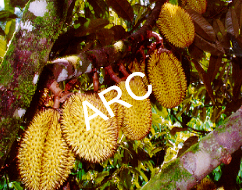|
PENANAMAN DURIAN
1. Nama Tempatan: Durian (Durio zibethinus)

2. Varieti yang disyorkan:
|
Klon
|
Ciri-ciri
|
| Klon Komersial |
| D96 |
Saiz sederhana dan kulit berwarna hijau. Isi berwarna kuning cair, manis dan berbau harum. Biji besar dan hasil tinggi. |
| D24 |
Saiz sederhana, Isi tebal dengan biji besar. Isinya berwarna kekuningan, lembut, tekstur halus dan bau yang kuat. |
| D99 |
Saiz kecil (1.0- 1.4 kg), agak bulat dan lobus yang menonjol. Isi tebal kekuningan dan mempunyai bau yang kuat. Hasil yang tinggi. |
| D123 |
Berasal dari Thailand dan juga dikenali sebagai Chanee. Buah besar (1.8-2.5 kg), berbentuk oval dan berwarna hijau kekuningan. Kualiti buah sederhana dan berhasil tinggi. |
| D168 |
Pokok yang sederhana tinggi dan hasil tinggi. Purata berat buah ialah 1.4-1.6 kg dan berbentuk agak bulat. Warna hijau coklat dan tangkai yang pendek. Isi tebal, manis, warna kuning kemerahan dan lunak. |
| DS68 |
Klon ini daripada pemilihan klon tempatan yang mempunyai pokok besar. Buahnya kecil 0.5-1.5 kg, berbentuk bulat dan berwarna keperangan. Isinya berwarna kekuningan dan tebal. Hasil tinggi dan konsisten. |
| MDUR 78 |
Berbuah dipertengahan musim dengan hasil yang tinggi. Berat 1.5-1.8 kg. Berbentuk bulat oval dengan isi kekuningan dengan kualiti dimakan yang baik. |
| MDUR 79 |
Gugur awal dan bersaiz sederhana. Hasil rendah daripada MDUR 78. Berbentuk bulat oval dan warna kekuningan. Isi tebal dan kualiti dimakan yang baik. |
| MDUR 88 |
Berbuah dipertengahan musim dengan hasil sederhana. Saiz buah sederhana dan is berwarna kuning keemasan, manis, sederhana halus dan agak kering berbanding dengan MDUR 78 dan MDUR 79. |
| Klon Tempatan |
| a) Durian kuning |
Kebanyakan ditanam di kawasan utara Sarawak. Mempunyai kualiti dimakan yang baik. Disyorkan ditanam bercampur dengan klon lain. |
| DG5 |
Pokok sederhana besar. Berbentuk bulat dengan warna kulit hijau dan berat 0.8-1.9 kg. Isi berwarna oren dengan tekstur yang halus, lembut dan melekit, berbau sedap dan manis. |
| DG25 |
Berasal dari Kampung Quap, Bahagian Kuching. Bersaiz 0.8-1.4 kg, berwarna kuning kehijauan. Isi berwarna kuning dengan tekstur yang halus dan lembut. |
| Suluk2 |
Berasal dari Limbang. Purata saiz 0.8-1.5 kg dan kulit berwarna hijau kekuningan. Isi berwarna kuning keorenan dan berasa manis dan berbau sedap. |
| Suluk3 |
Berasal dari Limbang. Saiz buah sederhana kecil 0.7-1.0 kg, berbentuk elips dan kulit berwarna kekuningan. Isi berwarna kuning keorenan, berbau harum, tekstur yang halus dan lembut dan berbiji kecil. |
| b) Durian Nyekak |
Pokok sederhana. Kebanyakan ditanam di kawasan tengah dan utara Sarawak.Berbuah sebulan lebih awal berbanding dengan musim durian biasa. |
| DK5 |
Buah bulat, saiz purata 0.6-1.4 kg dengan kulit kuning keorenan. Duri yang pendek tajam dan elastik. Buah senang dikopek Isi berwarna kuning keorenan, tekstur melekit dan manis serta berbau harum. |
| DK6 |
Buah bulat, agak kecil (0.6-0.9 kg)dengan kulit berwarna kuning. Isi kuning kemerahan, tekstur yang lembut dan sederhana kering, manis dan berbau harum serta berbiji kecil. |
| DK8 |
Berbentuk oblong dan bertangkai pendek. Purata berat ialah 0.6-1.2 kg dan berkulit kuning. Mudah dikopek, isi berwarna kuning, tekstur sederhana lembut dan kering, manis dan berbau harum. |
Penanaman klon bercampur termasuk D99 sebagai pendebunga (pollinator) adalah perlu untuk memperbaiki kejadian buah.
3. Keperluan Tanah dan Iklim
- Tanah lom bersaliran baik dan dalam
- Cuaca kering diperlukan untuk menggalakkan pembungaan.
4. Jarak Tanaman: 11m x 11 m (86 pokok/ha)
5. Pembajaan
|
Tahun
|
Kekerapan
|
Jenis Baja
|
Jumlah / Pokok / Tahun
(kg)
|
Kadar Pembajaan
(kg)
|
|
0
|
Semasa tanaman |
Rock Phosphate
Dolomite
Tahi Ayam |
|
|
|
1
|
Setiap 2bulan |
15:15:15 |
|
|
|
2
|
Setiap 3 bulan |
15:15:15 |
|
|
|
3
|
Setiap 3 bulan |
12:12:17:2+TE |
|
|
|
4
|
Setiap 3 bulan |
12:12:17:2:TE |
|
|
|
5
|
Setiap 3 bulan |
12:12:17:2:TE |
|
|
|
6
|
Setiap 4 bulan |
12:12:17:2:TE |
|
|
|
7
|
Setiap 4 bulan |
12:12:17:2:TE |
6.0
|
2.00
|
|
8
|
Setiap 6 bulan |
12:12:17:2:TE |
8.0
|
4.00
|
|
9
|
Setiap 6 bulan |
12:12:17:2:TE |
9.0
|
4.50
|
|
10 ke atas
|
Setiap 6 bulan |
12:12:17:2:TE |
|
5.00
|
Sebagai tambahan, baja tahi ayam 20 - 40 kg/pokok/tahun adalah disyorkan.
6. Tempoh Vegetatif: 4 - 7 tahun
7. Jangka umur ekonomik: 25 - 30 tahun
8. Penuaian dan Hasil
|
Umur (Tahun)
|
Hasil Buah (mt/ha/tahun)
|
|
7
|
1.3
|
|
8 - 10
|
5.3
|
|
11 - 13
|
10.6
|
|
14 - 25
|
13.2
|
9. Kawalan Perosak dan Penyakit
|
|
|
|
|
|
| 1. Penebuk biji durian |
|
Larva makan kulit buah pada mulanya dan akhirnya menebuk isi sehingga ke biji. Lubang sebesar 5-8 mm dikelilingi oleh tahi ulat berwarna putih oren kelihatan pada permukaan buah. |
|
- Perangkap lampu untuk mengurangkan populasi rerama
- Tiada kawalan kimia yang berdaftar
|
| 2. Penyakit Hawar Daun Rhizoctonia |
|
Fungi penyebab ialah Rhizoctonia solani. Bintik kecil pada daun, berwarna hijau kelabu membesar dengan cepat. Beberapa helai daun kelihatan melekat. |
|
Sembur dengan pencycuron.
Jarakkan pokok ditapak semaian dan elakkan siraman berlebihan pada anak semaian.
|
| 3. Kanker batang |
|
Disebabkan oleh kulat Phytophthora palmivora. Tompok-tompok hitam pada batang dan terdapat lelehan gam. Daun menjadi layu, lemah, berkurangan dan pokok akhirnya mati. Jangkitan pada buah mengakibatkan tompok lembik dan berair dan memberi rasa pahit. |
|
Sapu dengan racun seperti metalaxyl atau fosetyl-aluminium. Pada akar yang diserang, buat siraman racun yang sama. |
| Atas |
|

